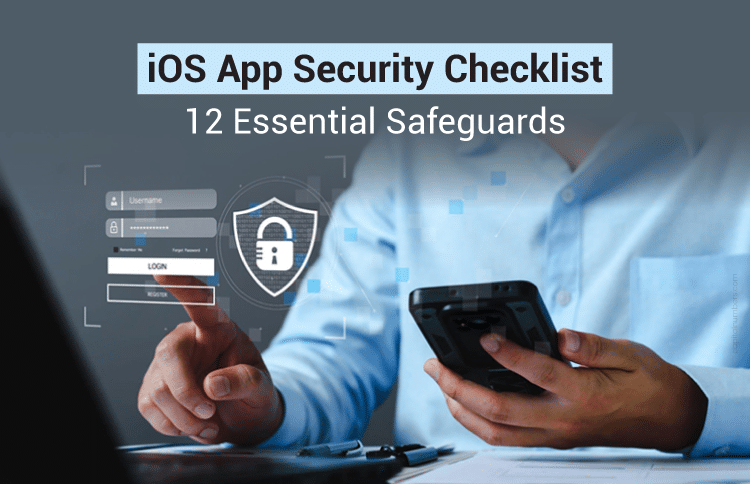iOS App Security Checklist: 12 Essential Safeguards
Table of Contents
Is your iOS app truly secure – or just assumed to be? As mobile apps become vital for customer engagement, operations, and handling sensitive data, strong iOS app security is more important than ever. While Apple provides built-in protections, apps can still be vulnerable if key security measures are overlooked – putting your business at risk of data breaches, financial loss, and reputational damage.
For CEOs, CTOs, and business owners, iOS app security isn’t just a technical concern – it’s a strategic priority. In this blog, we’ll walk you through a practical iOS app security checklist with 12 essential practices to help you protect your app, your users, and your business.
Why iOS App Security Is Critical for Your Business?
Before we walk through the iOS app security checklist, let’s look at why it matters. iOS apps often handle sensitive customer data, financial transactions, and proprietary business logic. A single vulnerability can lead to data breaches, compliance failures, and loss of user trust.
Strong iOS app security helps you:
- Protect user data and privacy
- Prevent unauthorized access and tampering
- Comply with regulations like GDPR and HIPAA
- Maintain brand reputation and customer confidence
- Avoid costly downtime and remediation
Whether you’re a startup or an enterprise, investing in app security is a proactive step toward long-term success.
Who Defines iOS App Security Standards?
The iOS app security baseline is guided by several key industry standards:
- Apple: Sets the foundation through guidelines like the App Store Review Guidelines and App Transport Security (ATS).
- OWASP: Provides security best practices through the OWASP Mobile Security Testing Guide, focusing on common risks like data leaks and insecure storage.
- Industry Standards: Businesses may also need to comply with other regulations, such as the GDPR or SOC 2, depending on their sector.
These standards help ensure iOS apps are secure, reliable, and compliant with necessary regulations.
iOS App Security Checklist to Follow
Use this checklist to identify and fix common vulnerabilities, strengthen your app’s defenses, and ensure a secure experience for every user. Each check is a practical step toward better iOS App Security.
1. Secure Data Storage
- What the Check Is: This involves encrypting sensitive user data while stored on the device. It’s crucial to use strong encryption methods, such as AES (Advanced Encryption Standard), to protect personal information, including passwords and payment details.
- Why It Matters to Business Leaders: Secure data storage is crucial for ensuring compliance with data protection laws, such as GDPR and CCPA. It also builds customer trust, as users feel safe knowing their data is protected.
- What Happens If It’s Ignored: If you fail to encrypt sensitive data, your iOS app is exposed to unauthorized access, increasing the risk of data breaches. This can lead to legal consequences, financial penalties, and a damaged reputation.
2. Network Communication Encryption (TLS/SSL)
- What the Check Is: This involves encrypting communication between the app and the server using TLS (Transport Layer Security) or SSL (Secure Sockets Layer) protocols. This ensures that sensitive data in your iOS app is protected during transmission.
- Why It Matters to Business Leaders: Encrypted communication keeps data secure while it travels between the iOS app and the server, preventing interception by attackers. It’s a basic but critical element of mobile app security.
- What Happens If It’s Ignored: Without encryption, hackers can intercept data of your iOS app, leading to man-in-the-middle attacks. This compromises user data and can result in loss of trust, security breaches, and potential financial loss.
3. Authentication and Session Management
- What the Check Is: Implementing multi-factor authentication (MFA) and managing user sessions securely. This involves verifying user identities and controlling access to sensitive areas of the iOS app.
- Why It Matters to Business Leaders: Strong authentication is a safeguard against unauthorized access to user accounts. It’s vital for preventing fraud and ensuring that only legitimate users access sensitive data and thus, enhance iOS app security.
- What Happens If It’s Ignored: Weak authentication increases the likelihood of unauthorized access and session hijacking. This can lead to data theft, financial fraud, and a reputation crisis.
4. Secure Coding Practices
- What the Check Is: Following secure coding guidelines (e.g., OWASP and Apple’s Secure Coding Guide) to reduce vulnerabilities in the app’s code. This helps prevent common security flaws, such as SQL injection or cross-site scripting (XSS).
- Why It Matters to Business Leaders: Secure coding practices for mobile app development are essential for protecting your app from being exploited by hackers. It helps ensure that your app is robust and resistant to common attacks.
- What Happens If It’s Ignored: Poor coding during iOS app development can lead to severe vulnerabilities, such as data breaches or app exploits, which may result in reputation damage, legal penalties, and financial losses.
5. Jailbreak Detection
- What the Check Is: This involves detecting and preventing the app from running on jailbroken devices, which bypass iOS security measures and allow unauthorized access.
- Why It Matters to Business Leaders: Jailbroken devices are highly vulnerable to attacks, meaning that if your app runs on such devices, user data is at risk. Preventing this ensures that your iOS app operates in a secure environment.
- What Happens If It’s Ignored: If the app runs on a jailbroken device, it can expose your app to attacks, such as unauthorized data access, leading to data leaks and loss of user trust.
How We Enhanced iOS and Android Apps for the Service Marketplace
The client’s service marketplace platform had separate versions for iOS and Android, both needing enhancements. We worked on key features like OTP-verified logins, smarter search, better chat functionality, secure payment gateways, and much more.
Learn how our talented developers used MVVM architecture, Realm DB, Elasticsearch, Firebase, and other powerful tools to make the apps faster, more secure, and user-friendly. [Read the full case study here]
6. App Transport Security (ATS) Enforcement
- What the Check Is: Enforcing App Transport Security (ATS) to ensure that all communication within the app uses HTTPS and complies with secure connection protocols.
- Why It Matters to Business Leaders: ATS helps enforce secure HTTP connections, preventing weak or insecure connections that might expose sensitive data. It is a critical security feature that protects data from being intercepted.
- What Happens If It’s Ignored: Failing to implement an ATS means using unsecured communication, making it vulnerable to data interception and other attacks, which can lead to security issues and user dissatisfaction.
7. Keychain Usage for Sensitive Data
- What the Check Is: Securely storing sensitive information, such as passwords and authentication tokens, in the iOS Keychain, a system that securely handles user credentials and secrets.
- Why It Matters to Business Leaders: The Keychain is a secure storage mechanism provided by iOS that helps protect sensitive data. It’s a critical component of mobile app security.
- What Happens If It’s Ignored: If Keychain usage is not implemented, sensitive data can be exposed to unauthorized access, increasing the likelihood of data theft and compromise.
8. Secure Logging and Debugging Controls
- What the Check Is: Ensuring that sensitive data isn’t accidentally logged during the development or production phase. This includes preventing the logging of personal user information or credentials.
- Why It Matters to Business Leaders: Sensitive data exposure through logs can result in a data breach if the logs are accessed by unauthorized parties. Proper logging controls are essential for maintaining privacy and security.
- What Happens If It’s Ignored: Improper logging can lead to the exposure of sensitive data, resulting in data leaks and security risks that can damage your brand’s reputation.
Need expert help to secure your iOS app?
Hire skilled iOS developers from Capital Numbers to create secure, scalable, and reliable mobile solutions. Let’s make your app safe and powerful, while keeping it smooth for users.
9. Privacy Permissions and Data Minimization
- What the Check Is: Ensuring the app only requests necessary permissions from users, and follows data minimization practices by collecting only essential data.
- Why It Matters to Business Leaders: By limiting the data collected and requesting only necessary permissions, businesses can ensure compliance with privacy regulations, such as GDPR, while maintaining user trust.
- What Happens If It’s Ignored: Over-collecting user data or requesting unnecessary permissions can lead to privacy violations, user distrust, and potential legal consequences.
10. Certificate Pinning
- What the Check Is: Implementing certificate pinning to validate SSL certificates and prevent man-in-the-middle (MITM) attacks.
- Why It Matters to Business Leaders: Certificate pinning ensures that your app communicates only with trusted servers, safeguarding data and preventing attackers from intercepting sensitive information.
- What Happens If It’s Ignored: Without certificate pinning, attackers can impersonate your server and intercept data, leading to data compromise and a breach of trust.
11. Runtime Protection and Code Obfuscation
- What the Check Is: Using runtime protection and code obfuscation to prevent unauthorized access to your app’s source code, making it harder for hackers to reverse-engineer.
- Why It Matters to Business Leaders: Code obfuscation helps protect intellectual property and prevents hackers from exploiting vulnerabilities in your app’s logic. It’s essential for securing proprietary business logic and sensitive functions.
- What Happens If It’s Ignored: If code obfuscation is neglected, attackers can reverse-engineer your app, steal intellectual property, or find vulnerabilities, leading to security breaches and exploitation.
12. Compliance with Apple’s App Store Guidelines
- What the Check Is: Ensuring that the app meets Apple’s App Store security and privacy requirements during the development and submission process.
- Why It Matters to Business Leaders: App Store compliance ensures that your app is accepted by Apple, making it available for users to download and install. It also guarantees your app adheres to the security standards required by the platform.
- What Happens If It’s Ignored: Failing to meet Apple’s security guidelines can result in app rejection, delays in launch, and potentially lead to losing access to the App Store, thereby limiting your app’s market reach.
By following this iOS app security checklist, businesses can ensure their apps meet the highest security standards, protect user data, ensure compliance, and safeguard their brand’s reputation. With these essential checks in place, you can confidently manage your mobile app development and mitigate the risks associated with app security.
How to Implement iOS Security Checks Without Slowing Development?
Strong iOS app security doesn’t have to slow down iPhone app development. By incorporating security early, automating key checks, and collaborating with security-focused teams, you can efficiently meet the iOS security standards without compromising speed or quality.
Make Security Part of Your Development Workflow
- Shift left on security: Begin iOS security testing early using automated audits and static analysis to catch issues before they escalate.
- Automate checks: Tools like SonarQube help enforce iOS security best practices throughout the development cycle.
- Follow secure coding standards: Implement encryption and secure coding into your team’s daily workflow to align with the iOS security checklist.
- Train early: Equip your team with iOS app security knowledge to make secure development an integral part of your process.
Automate Compliance with the Right Tools
Use these tools to streamline your iPhone app security checklist:
- Static analysis tools: Tools like Fortify and Checkmarx automatically detect vulnerabilities and align with the iOS security standards.
- Security libraries: Libraries like OpenSSL, Apple’s CryptoKit, and TrustKit simplify encryption and secure data storage.
- Automated audits: Run regular iOS app security audits with tools like OWASP Dependency-Check, Retire.js, and Snyk to identify outdated dependencies and potential risks.
These tools help maintain mobile app security without slowing the app development process.
Partner with Security-Focused Teams
Collaborating with experienced teams ensures smooth implementation:
- Efficient integration: Experts can add multi-factor authentication and encryption without disrupting workflows.
- Proactive risk management: Be aware of emerging threats and vulnerabilities.
- Streamlined compliance: Pass audits faster and avoid costly rework.
- Balanced delivery: Maintain speed and quality while meeting security requirements.
By integrating security early, automating checks, and partnering with experts, you can meet the iOS security standards and launch a secure app on time. This proactive approach protects user data and strengthens your mobile app security posture.
You May Also Read: Don’t Get Hacked: Essential Software Security Checklist for Developers
Bottom Line
Ensuring iOS app security is crucial in the mobile app development process. By following the iOS security checklist and implementing the key security checks, you can protect user data and safeguard your brand reputation. The key is to integrate security early into the development cycle, using the right tools, frameworks, and expert teams to automate compliance without slowing progress.
By adopting iOS security best practices, automating checks, and partnering with security-focused teams, businesses can build secure, reliable, and compliant apps that meet industry standards. A proactive approach to security ensures timely app launches while keeping user data protected.

















